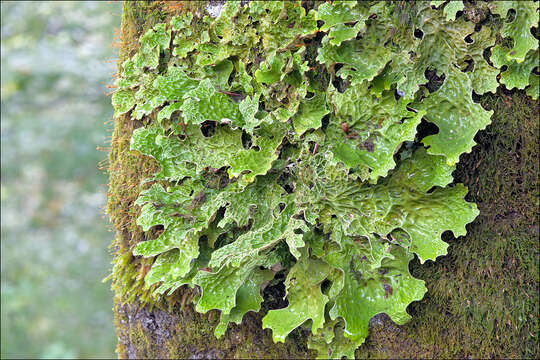Lobaria-pulmonaria_61

Description:
Lobaria pulmonaria (L.) Hoffm.Lungwort, Lung Lichen, DE: Echte LungenflechteSlo.: navadni pljuarDat.: Oct. 15. 2016Lat.: 46.34315 Long.: 13.71151Code: Bot_1018/2016_DSC5742File names: from Lobaria-pulmonaria_raw_60 to Lobaria-pulmonaria_raw_69.Habitat: Mixed alpine forest, Fagus sylvatica and Picea abies dominant trees, steep mountain slope, southwest aspect; calcareous ground; quite sunny place since the surrounding forest was mostly cut down a few years ago; protected from direct rain by tree canopies; average precipitations ~ 3.000 mm/year, average temperature 3-5 deg C, elevation 1.180 m (3.900 feet), alpine phytogeographical region. Substratum: Bark of a large Fagus sylvatica.Place: Lower Trenta valley, side valley Vrsnik, above village Na Skali, near the dirt road to Dol pod Plazmi place, East Julian Alps, Posoje, Slovenia EC. Comment: Lobaria pulmonaria is very beautiful and one of the largest lichens of Slovenia. It is the most beautiful after a few rainy days. Then dry it is brownish or dull green, but when moist it becomes shiny green. Since it is very sensitive to air pollution it is in sharp decline in Europe and hence protected in many countries. As such it is used as an indicator of rich, healthy and undisturbed ecosystems. Lobaria pulmonaria can be quite common in its ideal habitat; however, actually it is quite a rare find nowadays, particularly in low-land industrial countries. It occurs most often in shady environments. Green algae give Lobaria pulmonaria its bright green appearance. The underside of this lichen is whitish with pockets of cyanobacteria (blue-green algae). Hence this species is an association of three much different living beings: fungus and two kinds of algae.Its main method of reproducing is by tiny granule-like isidia or soredia, which develop on the edges of its talus (Fig. 63), eventually break off and fall on ground or in crevices of three bank, where they can grow into new lichen. Sometimes Lobaria pulmonaria also has spore-producing structures called apothecia that spread fungal spores. But apothecia are very rarely observed.Index Herbariorum LJFRef.:(1) I.M. Brodo, S.D. Sharnoff, S.Sharnoff, Lichens of North America, Yale Uni. Press (2001), p 417.(2) V. Wirth, Die Flechten Baden-Wuerttembergs, Vol.2. Ulmer (1995), p 563.(3) F.S. Dobson, Lichens, The Richmonds Publishing Ca. LTD (2005), p 255.(4) C.W.Smith, et all, The lichens of Great Britain and Ireland,The British Lichen Society (2009), p 561.
Included On The Following Pages:
- Life (creatures)
- Cellular (cellular organisms)
- Eukaryota (eukaryotes)
- Opisthokonta (opisthokonts)
- Nucletmycea
- Fungi (mushrooms, lichens, molds, yeasts and relatives)
- Dikarya
- Ascomycota (sac fungi)
- Lecanoromycetes
- Peltigerales
- Lobariaceae
- Lobaria (lung lichen)
- Lobaria pulmonaria (Lungwort)
This image is not featured in any collections.
Source Information
- license
- cc-by-nc-sa
- copyright
- Amadej Trnkoczy
- photographer
- Amadej Trnkoczy
- original
- original media file
- visit source
- partner site
- Flickr Group
- ID


